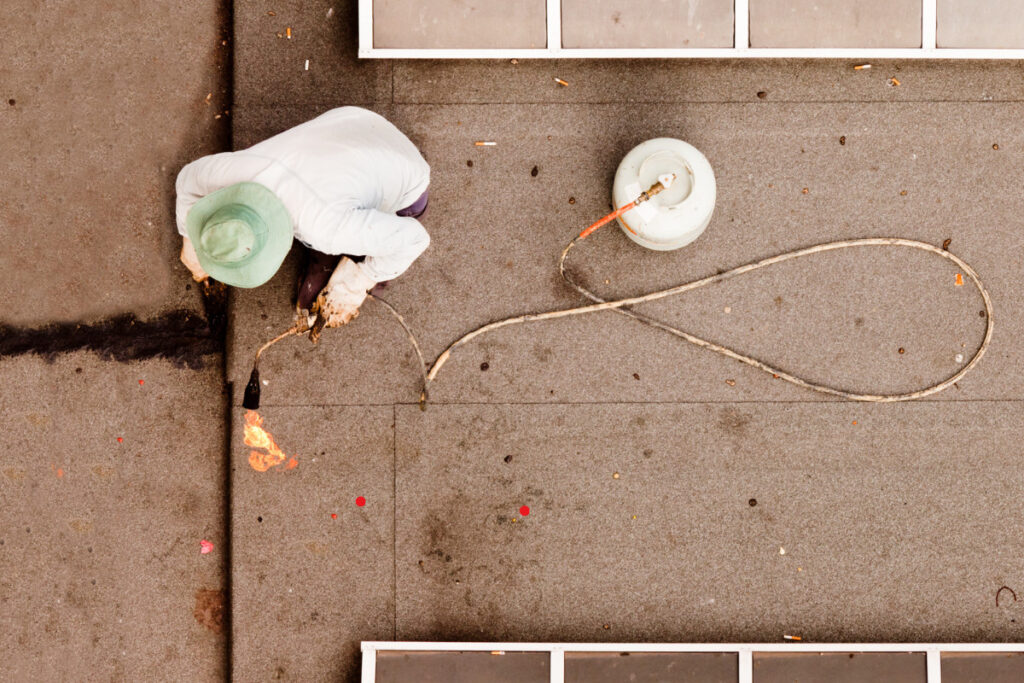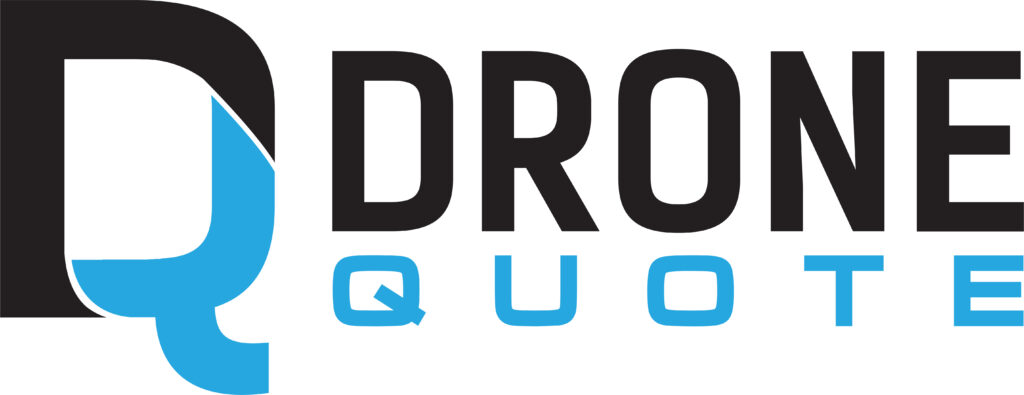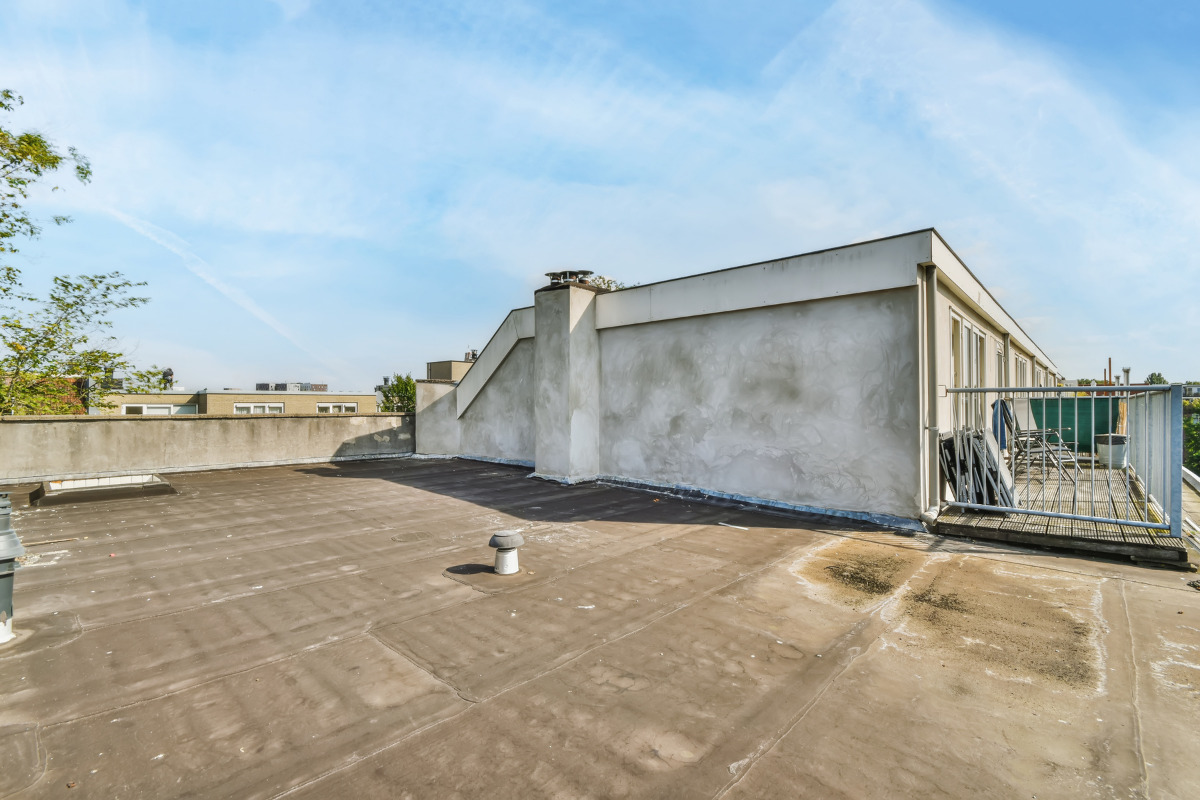Introduction
Welcome to DroneQuote, your trusted online marketplace for solar and roofing solutions. Do you have a flat residential roof? Our mission is to make your roofing journey as smooth as possible by providing honest, educational, and quality quotes from various reputable solar & roofing companies.
We understand that homeowners value convenience, so we offer an easy-to-use platform where you can learn about the different materials used in flat residential roof components and make informed decisions. To ensure accuracy in our measurements, we deploy drone technicians who perform detailed site analysis before and after the installation process. Join us today to explore a simpler way of maintaining and upgrading your home’s roof with DroneQuote’s professional guidance!
Understanding The Components Of A Flat Residential Roof
The components of a flat residential roof include decking, underlayment, membrane, flashing, insulation, drainage, and parapet walls.
Decking
Your flat residential roof starts with a fundamental component known as decking. The decking is your roof’s foundation and is the primary layer between your home’s structure and the roofing elements that protect it from external factors. Generally constructed from wood, metal, or concrete materials, this sturdy surface supports other essential components like underlayment and insulation.
With proper installation and maintenance, a durable deck will significantly contribute to extending the lifespan of your entire roofing system. For instance, using high-quality materials such as plywood or strong-oriented strand board (OSB) in constructing the deck can better resist moisture penetration and potential damage to internal structures. By understanding what goes into quality decking, homeowners can make informed decisions while working with their contractors to ensure that their roofs are built on solid foundations.
When considering different roofing options for your home, it’s essential to remember how crucial choosing an appropriate decking material is to prevent costly complications down the line. DroneQuote makes this process simple by offering honest, educational quotes from trusted solar & roofing companies explicitly tailored to your needs while providing helpful insights about important components like decking so you can make confident decisions when investing in your flat residential roof.
Underlayment
The underlayment is an essential component of a flat residential roof, providing an extra layer of protection against water damage. It is a barrier between the roofing material and the supporting decking or sheathing. Flat roof underlayment materials include asphalt-saturated felt paper, synthetic underlayments, rubberized asphalt sheets, and advanced options like TPO with excellent waterproofing qualities.
Selecting the appropriate type of underlayment based on professional guidance is crucial because each option has advantages and drawbacks depending on factors such as climate conditions in your area or specific requirements. For long-term performance, regular inspections play a vital role in ensuring your roof’s underlayment remains in good shape. Homeowners should not hesitate to seek professional assistance if they notice signs of standing water around their property after rainfall events or suspect their roofs may be prone to leaks due to age or wear and tear. Catching potential issues
early can prevent more extensive problems – resulting in significant cost savings while safeguarding both comfort levels indoors and overall structural integrity over time.
Membrane
In constructing a flat residential roof, the membrane is a crucial component that protects against water penetration and harsh weather conditions. This waterproof barrier is typically made from different materials such as thermoplastic olefin (TPO), ethylene propylene diene monomer (EPDM), or polyvinyl chloride (PVC). Each material has unique properties, advantages, and disadvantages regarding performance, durability, and cost-effectiveness.
For instance, TPO membranes are known for their heat-weldable seams and energy efficiency due to their high reflective qualities. In contrast, EPDM is prized for its long-lasting resilience in extreme temperatures and resistance to ultraviolet rays. On the other hand, PVC roofing membranes offer enhanced chemical exposure resistance and excellent fire-retardant capabilities. As homeowners considering a new flat roof or upgrading an existing one, understanding these membrane options can help you decide which type best suits your needs.
Understanding available membrane materials helps select a roofing solution that meets budget, structural requirements, and provides longevity and protection. DroneQuote provides accurate quotes based on quality evaluations using drone technology, empowering homeowners to invest in an excellent and functional roofing system.
Flashing
Flashing is an essential component of any flat residential roof. It is a thin material, typically made of aluminum, steel, or copper, that protects seams and joints from water damage. Without it, rainwater can seep into your home through tiny cracks in the roof and cause mold growth or structural damage.
To ensure that your flashing is functioning correctly, it should be checked routinely by a professional roofing contractor like those available through DroneQuote. They will examine the condition of the flashing around all penetrations on your roof during their inspection to ensure they are properly sealed against potential leaks or water invading your home’s interior.
When you choose DroneQuote for your roofing needs, rest assured that our partner contractors will perform thorough inspections with attention paid to every detail to prevent future issues while providing honest quotes with educational components about what makes up a high-quality residential flat-roof installation/repair – even down to the importance of something as simple as flashing!
Insulation
Insulation is an essential component in a flat residential roof. It helps regulate the temperature inside your house, making it more comfortable. The insulation material is installed directly under the roofing membrane and is a barrier between your home and the outside environment. Good quality insulation can prevent heat from escaping during winter and keep cool air inside during summer.
But why is good insulation important? It helps you save money on energy bills by reducing heating or cooling costs. Also, properly installing insulating materials can help prevent moisture buildup that can lead to mold growth or damage to your roof decking. This damage could be costly if not addressed early enough, making understanding how insulation works essential for homeowners.
Choosing suitable insulation for your roof can be overwhelming, but DroneQuote’s experienced professionals educate you on options based on their insulating ability. Honest quotes from trusted roofing companies ensure informed decisions for your new flat residential roof insulation.

Drainage
Drainage is a critical component of any flat residential roof. It refers to the mechanisms to prevent water from collecting on your roof and causing damage. A proper drainage system will help divert water from your home, protecting it against leaks and other water damage.
One vital part of your drainage system is your gutters. These channels safely carry rainwater from your roof to the ground. They should be cleaned regularly to ensure they don’t become clogged with debris, which can cause them to overflow during heavy rains.
Another important aspect of drainage is the slope or pitch of your roof. A properly sloped roof will allow rainwater to flow freely into the gutters instead of pooling up on top of the membrane or underlayment layers. Suppose you notice any standing water on your flat residential roof after rainfall. In that case, this may indicate poor drainage and requires an expert roofing contractor’s attention as soon as possible.
Parapet Walls
As part of a flat residential roof, parapet walls are a barrier to prevent water from flowing over the edge. These are vertical walls that extend above the roofline and can also provide support for various rooftop equipment, such as HVAC units. Parapet walls can be constructed using different materials like brick, stone, or stucco, depending on your location and style preferences.
DroneQuote offers resources and quotes from trusted roofing companies to help maintain your parapet walls and overall roof health. Proper maintenance prevents water infiltration and potential mold growth and structural damage. Additionally, parapet walls should be regularly inspected for cracks or signs of wear to avoid costly repairs down the line.
Understanding the components of your flat residential roof, such as decking, underlayment, membrane, flashing, insulation, drainage, and parapet walls, helps identify potential problems early on. This allows for confident communication with roofing contractors and informed decisions about solar power upgrades or new roofing installations.
Why Knowing About Roof Components Is Important
Knowing about the components of a flat residential roof is important as it enables homeowners to make informed decisions, identify and address potential problems early on, and communicate better with roofing contractors.
Making Informed Decisions
Understanding the various components of your flat residential roof can help you make informed decisions about repairs, maintenance, and replacement. By knowing what each component does and how it works together with others, homeowners can take an active role in managing their roofing needs. For example, notice water stains on your ceiling or walls. You can identify potential problem areas by understanding where moisture most likely seeps through the underlayment or membrane.
Making informed decisions can also save homeowners time and money in the long run. By addressing minor issues before they become major problems or leaks, costly repairs can often be avoided altogether. Additionally, knowing what materials are used in each part of your roof allows for better communication with roofing contractors when discussing options for repair or replacement.
At DroneQuote, we understand a homeowner’s knowledge level varies vastly regarding roofing components. That’s why we take the time to educate our clients on these essential elements so that they have all the information needed to make informed decisions about their home’s roofing needs.
Identifying And Addressing Potential Problems Early On
Homeowners need to understand the components of their flat residential roof and be able to identify potential problems early on. This can prevent costly repairs and save you from experiencing water damage or leaks inside your home. Knowing what to look for can help catch roof issues before they become major. Missing or cracked shingles, discolored spots, and water stains indicate a problem that needs attention.
Knowing how to address these problems is equally important. It’s always best to consult a qualified roofing contractor who can assess the damage and provide expert advice on the appropriate solution for your needs. Some standard solutions include repairing damaged areas, replacing missing or damaged shingles, fixing flashing issues around vents and chimneys, or improving ventilation in your attic space.
At DroneQuote, our team is committed to providing honest education about proper roof maintenance and identifying potential problems early on. We offer online quotes and use drone technology for accurate site analysis to keep you informed about your flat residential roof’s health and avoid costly repairs in the future.

Better Communication With Roofing Contractors
Being able to communicate effectively with your roofing contractor is crucial for the success of any roofing project. By understanding the various components of a flat residential roof, you’ll have a better idea of what to expect and be able to ask more informed questions. This will help you build trust with your contractor and ensure they deliver exactly what you need.
Discussing details like parapet walls and insulation with your roofer before work starts can prevent potential issues from becoming bigger problems.
At DroneQuote, we understand the importance of clear communication between property owners and contractors. That’s why our honest and educational quotes are designed to give homeowners all the information they need upfront. With this knowledge, customers can make informed decisions that benefit them in the long run by getting quality workmanship from trusted roofing companies.
By working together openly and honestly, we ensure every client clearly understands their options and what to expect throughout each stage of their project, ensuring total satisfaction at its completion!
The Benefits Of Proper Roof Maintenance
Proper maintenance of your flat residential roof not only prevents leaks and water damage but also extends the lifespan of your roof and ensures energy efficiency.
Prevention Of Leaks And Water Damage
One of the most important benefits of proper roof maintenance is preventing leaks and water damage. A small leak in your flat residential roof can become a significant problem, resulting in costly repairs to your home’s roof and interior. Regular inspections by roofing professionals can help identify potential areas where leaks may occur, such as damaged flashing or membrane, and take care of them before they become significant issues.
Preventing water damage not only saves money but also keeps your home safe and comfortable for your family. In addition to causing property damage, moisture from leaks can contribute to harmful mold growth. Regular maintenance and quality materials from DroneQuote’s network of trusted roofing companies can give homeowners peace of mind by protecting their homes from weather-related damages.

Prolonging The Lifespan Of Your Roof
Prioritizing maintenance for your flat residential roof is important to extend its lifespan. Neglecting regular upkeep, such as cleaning and inspection, can lead to minor issues becoming larger problems over time. For example, a debris buildup on your roof can damage the membrane causing leaks during heavy rain or snowstorms. However, you could avoid these issues with proper care and routine maintenance.
Regular inspections also help prevent premature aging and decay of roofing components due to weather exposure. Over time, UV rays from the sun break down materials like insulation and underlayment, causing them to wear out faster than expected. By identifying potential problems early on through professional inspections, you can address them promptly before they worsen.
Energy Efficiency
An adequately maintained flat residential roof can go a long way in ensuring energy efficiency. One of the critical components that contribute to this is proper insulation. Insulation regulates home temperature for comfort all year round. This means you will not have to rely heavily on HVAC systems, resulting in lower energy bills.
Another way to ensure energy efficiency is by selecting the right type of roofing material. Reflective or cool roofs reflect sunlight, reduce heat absorption, lower indoor temperatures, and save energy. They also prevent roof degradation from high temperatures, saving homeowners money on cooling costs.
Insulation and material selection for energy efficiency can save you money, help the environment, and make your home more comfortable. DroneQuote knows this well and offers honest quotes for the best roofing options.
How DroneQuote Can Help With Your Roofing Needs
DroneQuote offers a convenient and efficient way to address your roofing needs, with accurate measurements through drone technology, honest and educational quotes, and multiple options from trusted roofing companies.
Online Convenience
Our platform offers a convenient way for homeowners to get quotes for their roofing needs without making phone calls or dealing with pushy salespeople. With just a few clicks, you can receive multiple quotes tailored to your specific needs from trusted roofing companies.
Our team is dedicated to educating clients about their options so they can make informed decisions regarding their roofing needs. Additionally, we use drone technology for more accurate roof measurements, providing before-and-after comparisons that help assess quality workmanship. Trust our platform for all your online purchasing needs related to roofs and solar panels.
Accurate Measurements With Drone Technology
How can we accurately measure your roof without stepping foot on it? The answer is simple: drone technology. At DroneQuote, we use drones to perform a site analysis of your home’s roof and gather precise measurements. These allow us to provide you with honest and educational quotes from trusted roofing companies.
Our cutting-edge drone technology can capture detailed images of every inch of your roof. Which are then translated into accurate measurements using specialized software. This eliminates the need for traditional methods like climbing up to measure by hand or estimating based on satellite imagery, which can result in inaccurate readings.
Our commitment to accuracy extends beyond the initial measurement process. Our fiduciary approach means that we also conduct before-and-after comparisons as part of our drone surveying process. We ensure that all work done meets our high standards for quality and workmanship. Trust us at DroneQuote – let us help ensure you get an honest quote from reputable roofing companies through accurate measurements using drone technology!

Honest And Educational Quotes
As a homeowner, you must have a reliable roofing contractor that you can trust. At our company, we believe in providing transparent and honest quotes with no hidden fees. We also offer educational resources on the components of residential roofs. So that you can make informed decisions about your roof needs.
For high-quality roofing services, turn to us for all your needs! Our team is dedicated to making the process as straightforward and thorough as possible. We are always available to answer any questions or concerns you may have. Our emphasis on honesty and education builds trust with our clients, setting us apart from competitors in the industry.
Multiple Quotes From Trusted Roofing Companies
Finding the right roofing company can be a daunting task. That’s why we provide multiple quotes from trusted professionals for you to compare and choose from. With different options, you’ll better understand the project’s cost and what each company offers in terms of services and materials.
Our network comprises highly vetted roofing companies with years of experience and reputable workmanship within their industry. We screen each professional rigorously to ensure quality service delivery. You never have to worry about hidden fees or charges. All provided quotes are transparent regarding costs and offered services.
Testimonials And Contact Information
In conclusion, understanding the different components of a flat residential roof is crucial for homeowners. It allows them to make informed decisions, identify potential problems early on and communicate better with roofing contractors.
Proper maintenance can also prevent leaks and water damage, prolong the lifespan of your roof, and increase energy efficiency. With DroneQuote’s online convenience and accurate measurements using drone technology, you can receive honest and educational quotes from trusted roofing companies all in one place. Don’t hesitate to use our services today and experience hassle-free roofing like never before! Contact us now to get started.
FAQs
1. What are the main components of a flat residential roof?
Flat residential roofs typically consist of several key elements. This includes decking, insulation, roofing membrane or system, drainage system, and flashing details around penetrations such as skylights or vents.
2. Why is it essential to have proper drainage on a flat residential roof?
Ensuring the water drains appropriately off your flat roof prevents structural damage and leaks over time. Flat roofs generally don’t shed water as sloped roofs do. So, adequate drainage systems must be in place to avoid standing water which can cause problems for underlying structures.
3. What roofing membranes are commonly used for flat residential roofs?
The most common materials for flat roof coverings include traditional asphalt/bitumen-based products. These includes modified bitumen membranes (MBMs) or built-up roofing systems (BURs), liquid-applied coatings, and single-ply synthetic rubber-like TPO/EPDM/PVC membranes.
4. How often should I inspect my flat residential roof?
It’s recommended that you inspect your flat roofing system twice yearly. Once in springtime after the winter weather has passed and again in fall when preparing for winter months ahead. Regular inspections help detect damage early on and allow repairs before significant issues occur!

